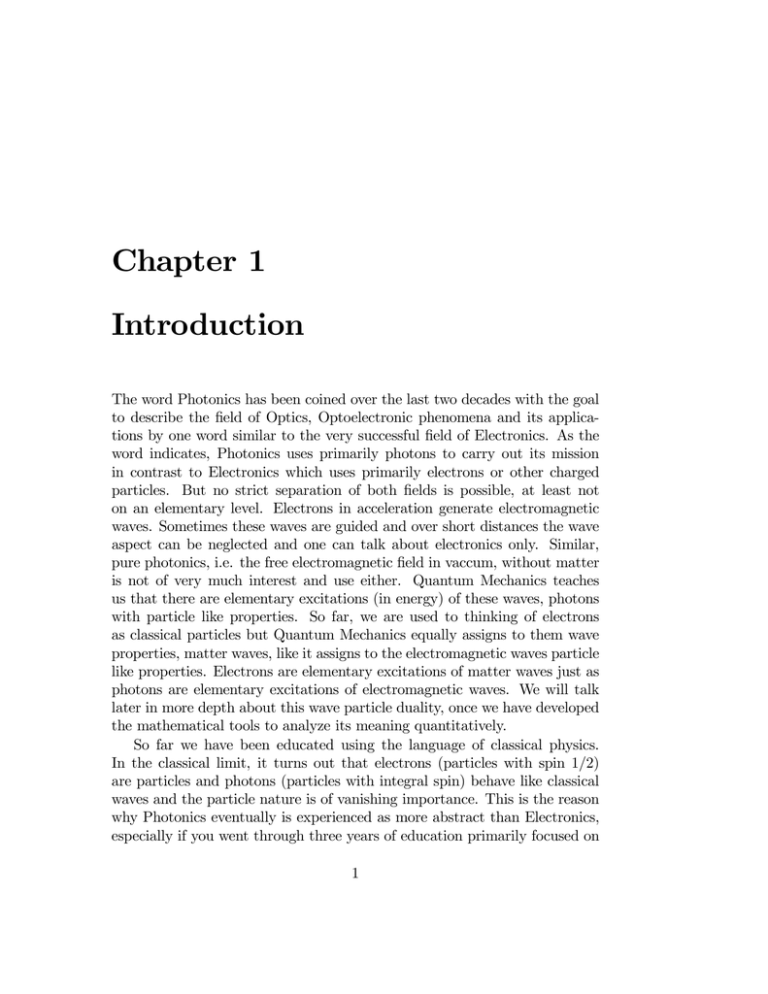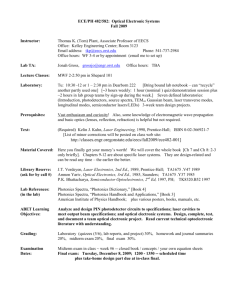Chapter 1 Introduction
advertisement

Chapter 1 Introduction The word Photonics has been coined over the last two decades with the goal to describe the field of Optics, Optoelectronic phenomena and its applica­ tions by one word similar to the very successful field of Electronics. As the word indicates, Photonics uses primarily photons to carry out its mission in contrast to Electronics which uses primarily electrons or other charged particles. But no strict separation of both fields is possible, at least not on an elementary level. Electrons in acceleration generate electromagnetic waves. Sometimes these waves are guided and over short distances the wave aspect can be neglected and one can talk about electronics only. Similar, pure photonics, i.e. the free electromagnetic field in vaccum, without matter is not of very much interest and use either. Quantum Mechanics teaches us that there are elementary excitations (in energy) of these waves, photons with particle like properties. So far, we are used to thinking of electrons as classical particles but Quantum Mechanics equally assigns to them wave properties, matter waves, like it assigns to the electromagnetic waves particle like properties. Electrons are elementary excitations of matter waves just as photons are elementary excitations of electromagnetic waves. We will talk later in more depth about this wave particle duality, once we have developed the mathematical tools to analyze its meaning quantitatively. So far we have been educated using the language of classical physics. In the classical limit, it turns out that electrons (particles with spin 1/2) are particles and photons (particles with integral spin) behave like classical waves and the particle nature is of vanishing importance. This is the reason why Photonics eventually is experienced as more abstract than Electronics, especially if you went through three years of education primarily focused on 1 2 CHAPTER 1. INTRODUCTION Electronics and its applications. The particle properties of electromagnetic waves become of importance when the energy of the photons considered, hf, where h is Planck’s constant and f is the frequency, is larger than the thermal energy stored in an electromagnetic mode, kT , where k is Boltz­ mann’s constant and T is temperature. At room temperature this is the case for frequencies greater than 6THz. For lower temperatures this transition frequency from classical to quantum behaviour may already occur at GHz frequencies. Certainly, at room temperature, the particle properties are im­ portant in the near infrared (IR) and visible spectrum where currently the bulk of the photonic activities are carried out, see Figure 1.1. Figure 1.1: Wavelength and frequency ranges of electromagnetic radiation and its use. An important task of Photonics is the development of coherent sources of radiation, which are in the optical range called LASER’s (Light Amplification by Stimulated Emission of Radiation). The first amplifier making explicit use of the quantum properties of matter was the MASER (Microwave Amplifi­ cation by Stimulated Emission of Radiation) invented by J. P. Gordon, C. H. Townes and Zeiger in 1954. The extension of the MASER principle to 3 the optical wavelength range was proposed by Schawlow and Townes in 1958 and the first laser was demonstrated in 1960 by Maiman [5]. As in the case of Electronics, Communications is a very important area in Photonics, and is usually called Optical Communications, which is carried out primarily in the infrared to visible wavelength range, see Figure 1.1. The enormous bandwidth available at optical frequencies, roughly four orders of magnitude higher than typical microwave frequencies (10GHz), enables the corresponding advance in information transmission capacity when compared to what electronics can do over a single long distance transmission link at microwave frequencies. Our current society could not be sustained without the worldwide deployed optical cable network, see Figure 1.2, which can be considered the largest connected machinery on earth. Understanding of the basic working principles of the components used in such lightwave networks, like the optical fiber itself, waveguide couplers, modulators, light sources is at the heart of this course. Image removed for copyright purposes. Figure 1.2: Worldwide underwater optical cable systems The big advantage of Photonics versus Electronics in the area of infor­ mation transmission is that photons do not interact with each other directly. Maxwell’s equations in the classical vacuum are linear. Whereas electrons, 4 CHAPTER 1. INTRODUCTION which are charged particles, show very strong interaction via their Coulomb fields. This is one reason why Photonics is very powerful in information trans­ mission; essentially no interference with other signals; whereas electronics is very strong in information processing which is based on nonlinear operations. Image removed for copyright purposes. Figure 1.3: High-Index Contrast SiN/SiO2 /Air Filter using Scanning Elec­ tron Beam Lithograph. Courtesy of H. Smith MIT-Nanostructures Labora­ tory As in the case of Electronics, miniaturization of many components and integration on a common technology platform is one of the major challenges in photonics (Integrated Optics). Over the last few years a new field called Silicon-Photonics came to life. Modern nanofabrication techniques such as Scanning Electron Beam Lithography enable the fabrication of optical com­ ponents on the scale of the optical wavelength with a relative precision in the few nanometer range in the same material system like electronics, i.e. sili­ con/silicon nitride/silicon dioxide, see Figure 1.3. Fig. 1.4 shows a measured 5 filter characteristic useful for optical communications applications. Systems that integrate both optical and electronic subsystems on a single chip called Electronic-Photonic Integrated Circuits are on the horizon. in drop stage through discard through th rough add Figure 1.4: Schematic and measured two stage third order ring filter. Cour­ tesy MIT-Optics and Quantum Electronics Group As with Electronics, Photonics has not only left its mark on communi­ cations but is used in a wide variety of sensing applications specific to its wavelength range as well as optical imaging, test and measurement instru­ mentation, manufacturing and materials processing. High power lasers with average powers of tens of kilowatts can cut many centimeter thick steel plates at high speed. Laser systems reaching petawatts (1015 Watt) of peak power were built at Lawrence Livermore Laboratory for the first time in 1996, (see Fig. 1.5) and much more compact versions are under construction at several laboratories around the world. The enormous peak power (the average power consumption of the earth is on the order of a few Terawatt (1012 Watt)), even though only available over a fraction of a picosecond, will enable us to inves­ tigate new physics and fundamental interactions at extreme intensities, such as the scattering of photons with each other invoking vacuum nonlinearities (the Quantum Electrodynamic Vacuum), see Figure 1.6 6 CHAPTER 1. INTRODUCTION Figure 1.5: First petawatt laser system installed at LLNL us­ ing chirped pulse amplification and the NOVA amplifier chain, see http://www.llnl.gov/str/MPerry.html. Because of the higher operating frequencies, optical sources can provide much higher time resolution than microwave sources. Therefore, it is not surprising that the shortest controlled events that currently can be made are optical pulses that comprise only a few cycles of light. These events are so short that one can only use the pulses themselves to reveal its pulse width, for example by performing an autocorrelation of the pulse with a copy of itself using a nonlinear element, see Fig. 1.7. 7 Image removed for copyright purposes. Figure 1.6: Progress in peak intensity generation from lasers over the last 45 years. Courtesy Gerard Mourou. 8 CHAPTER 1. INTRODUCTION Figure 1.7: Experimental setup for measureing an interferometric autocorre­ lation. A copy of the pulse is generated and interferometrically delayed with respect to the original pulse. The superposition of the two pulses undergo second harmonic generation in a crystal and the second harmonic light is detected. Figure 1.8 shows a measured interferometric second harmonic autocorrela­ tion trace of a 5fs (fs=femtosecond, 10−15 s) short pulse at a center frequency of 800nm [19]. 8 IAC 6 4 2 0 -20 -10 0 10 20 TIME DELAY, FS 30 Figure 1.8: Measured and fitted interferometric autocorrelation function of a 5fs pulse [19]. Femtosecond pulses have been used to understand the carrier dynamics in semiconductors, that limit the speed of electronic devices, the dynamics 9 of chemical reactions such as photosynthesis or the early stages of vision. As in any discipline the development does not stop and most recently pulses as short as 250 attoseconds (10−18 s)have been generated in the soft-x-ray regime [4]. Laser like sources potentially generating radiation up into the hard x-ray regime are being planned to be built over the next years [5]. The hope is that such sources enable the spatially and temporally resolved direct imaging of molecules and atoms undergoing reactions, which would advance medical diagnostics and drug discovery. As these examples show, Photonics is a booming area, despite the downturn of the Telecommunications industry. The basis for its success is fundamental and, therefore, it will continue to grow in importance with impact in our everyday lifes as has been the case with (Micro-) Electronics, just think about your high-speed internet connection or the CD-player. The course is organized as follows: In Chapter 2 we will review some con­ cepts of Classical Electromagnetism from 6.013, such as plane electromag­ netic waves in isotropic media, the related energy flow, and their properties upon reflections at interfaces. This will enable us to study various important optical devices such as prisms, interferometers, Fabry-Perot resonators and thin film interference coatings. The plane electromagnetic wave is an ideal­ ization similar to the perfect monochromatic sin or cosine in signal theory. We will use the plane waves to understand beams of finite size and discuss them as solutions to the paraxial wave equation, the Gaussian beams which in the limit of large beam size become optical rays. The concept of optical rays will enable us to discuss imaging properties and the design of optical systems. Then we will look into guided optical beams such as in optical fibers and waveguides from the point of view of ray optics and from the view point of full solutions to Maxwell’s equations. The concept of optical modes and resonances will be discussed. To understand optics in crystalline materials and related phenomena such as birefringence and its multiple use in opti­ cal components for polarization manipulation and switching we will briefly discuss wave propagation in anisotropic media. This basic training in wave physics puts us in an excellent position to understand Quantum Mechanics. We will revisit in chapter III the expermi­ mental facts appearing at the turn of the 19th century that lead to the dis­ covery of Quantum Mechanics. In chapter IV, we will find the Schroedinger Equation, a wave equation for matter waves, and introduce the formalism of Quantum Mechanics at the example of the harmonic oscillator and the hydrogen atom. Both systems are model systems for understanding pho­ 10 CHAPTER 1. INTRODUCTION tons and energy eigenspectra of quantum systems that can be fully solved analytically. Chapter V is devoted to the basic understanding of the interaction of light and matter and sets the basis for the study of the laser and its fundamental properties in chapter VI. In chapter VII the modulation of light using electro and acousto-optic effects is discussed. If time permits an introduction to the quantum theory of light fields and photo detection is also treated. Bibliography [1] T. H. Maimann, "Stimulated optical radiation in ruby", Nature 187, 493-494, (1960). [2] M. D. Perry et al., "Petawatt Laser Pulses," Optics Letters, 24, 160-163 (1999). [3] R. Ell, U. Morgner, F.X. Kärtner, J.G. Fujimoto, E.P. Ippen, V. Scheuer, G. Angelow, T. Tschudi: Generation of 5-fs pulses and octave-spanning spectra directly from a Ti:Sappire laser, Opt. Lett. 26, 373-375 (2001) [4] H. Hentschel, R. Kienberger, Ch. Spielmann, G. A. Reider, N. Milosevic, T. Brabec, P. Corkum, U. Heinzmann, M. Drescher, F. Krausz: "Attosec­ ond Metrology," Nature 414, 509-513 (2001). [5] John Arthur, "Status of the LCLS x-ray FEL program," Review of Sci­ entific Instruments, 73, 1393-1395 (2002). 11







